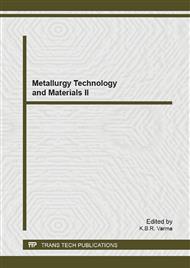p.479
p.484
p.489
p.492
p.497
p.502
p.506
p.514
p.519
Derivation of Optimum Study Factors for Samples Contaminated with Cd Using Electric/Magnetic Field and ORP
Abstract:
A purpose of the present study is to derive optimum study factors for removal of heavy metals using combined alternating current electric/magnetic field and electric membranes for the area contaminated with heavy metals in soil or underground water. ORP (Oxidation Reduction Potential) analysis was conducted to determine an intensity of tendency for oxidation or reduction of the samples contaminated with heavy metals, and electrical membrane treatment was used with adjustment of concentrations and voltages of liquid electrode (Na2SO4) to derive a high removal rate. Removal constants were analyzed to be 0.0417, 0.119, 0.1594 when the voltages were 5V, 10V, 15V, respectively, and treatment efficiency was shown to increase as the liquid electrode concentration was increased. Keywords: heavy metals, electric/magnetic field, ORP, electrical membrane
Info:
Periodical:
Pages:
519-524
Citation:
Online since:
September 2013
Authors:
Price:
Сopyright:
© 2013 Trans Tech Publications Ltd. All Rights Reserved
Share:
Citation:


